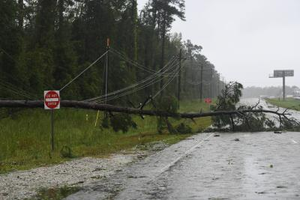America
Florida braces for powerful Hurricane Milton while still recovering from Hurricane Helene

October 7 :
As Hurricane Milton became stronger in the Gulf of Mexico and headed toward the western coast of the U.S. state of Florida on October 6, the state was getting ready for its biggest evacuation since 2017. This came just after Hurricane Helene, which had devastated the area the previous year.
U.S. National Hurricane Center predictions indicated that Milton, which intensified from a tropical storm to a hurricane on October 6, would likely impact the densely populated Tampa Bay area as a major hurricane on October 9. Helene, which made landfall farther north on September 26, was anticipated to exacerbate damage to places already struck by the new hurricane.
Emergency management division head Kevin Guthrie of Florida warned that the state might see the "largest evacuation that we have seen most likely since 2017 Hurricane Irma." Guthrie urged Floridians to escape during a press conference.
According to the National Hurricane Center, as of 7 p.m. EDT on Oct. 6 (0000 GMT on Oct. 7), Milton was located about 780 miles (1,255 km) west-southwest of Tampa. The storm was heading eastward toward Florida at 7 mph (11 kph), with maximum sustained winds of 85 mph (140 km).
The northern coast of the Yucatán Peninsula in Mexico was under a hurricane watch. It was anticipated to be upgraded from Category 1 on the five-step Saffir-Simpson scale, but the wind speed put it in that category anyway. It was anticipated by private weather forecaster AccuWeather to receive a 4 out of 5, indicating the potential for extensive catastrophic flooding, according to their scale.
Milton, according to Florida Governor Ron DeSantis, could cause more power outages and a bigger storm surge than Helene, and the damage from Helene might be worsened. In the event of a devastating hurricane, what will happen to the locations where there is a lot of debris? DeSantis warned that the damage would escalate significantly. "This is all hands on deck to get that debris where it needs to be."
At a news conference on September 30, Sheriff Bob Gualtieri announced that over half a million residents in the lowest lying regions of Pinellas County—which include St. Petersburg—would likely be ordered to evacuate. Twelve individuals lost their lives in the county and over 1,500 emergency calls went unanswered because people disregarded evacuation instructions during Hurricane Helene, so he pleaded with them to listen.
Cathie Perkins, the director of emergency management for the county, stated that a total of 6,600 people from six hospitals, twenty-five nursing homes, and forty-four assisted living institutions have already been told to evacuate. Between September 30 and October 2, classes will not be held.
"The impacts of this storm will exacerbate the years of rebuilding that we will already be experiencing due to Hurricane Helene," stated Ken Welch, mayor of St. Petersburg. Keep in mind that Hurricane Helene was veering off in the opposite direction, 100 miles (160 km) from where we were. We are about to be hit hard by a Category 2 or 3 hurricane.
More than 200 people were murdered in six states by Hurricane Helene, making it the deadliest named storm to strike the mainland U.S. since Hurricane Katrina in 2005. Much of the South, including North Carolina and Florida, is still recovering from the immense destruction left by the hurricane.
The number of active-duty troops being sent into western North Carolina to help with the response and recovery activities following Hurricane Helene increased by 500, according to U.S. President Joe Biden's statement on Sunday. This brings the total number of troops to 1,500.
The White House announced that they will be joining 6,100 members of the National Guard and 7,000 federal employees in a large recovery effort on behalf of states and municipalities. With economic losses expected to reach billions of dollars, the Biden administration has authorized $137 million in federal aid and pledged additional help would be forthcoming.



































